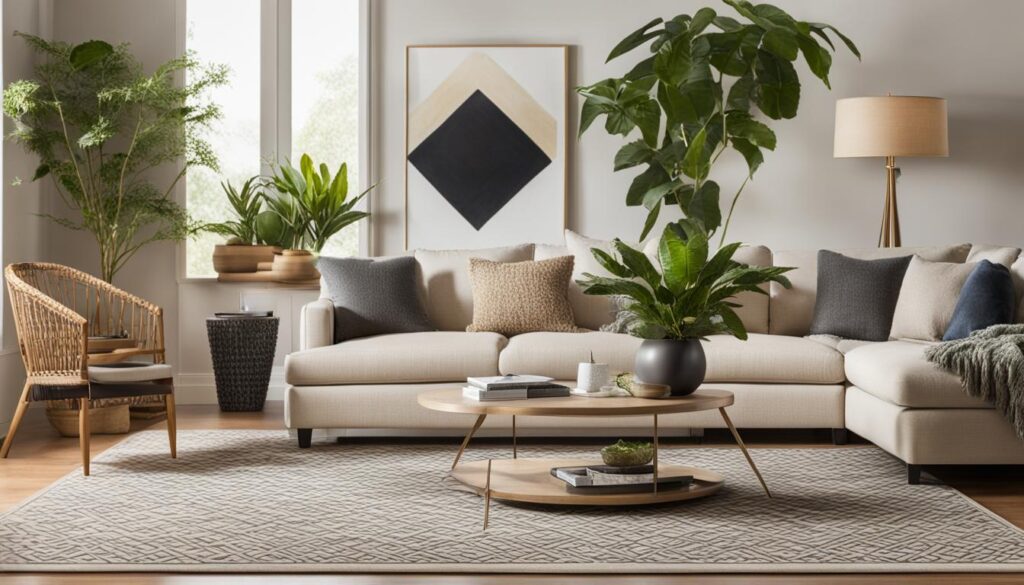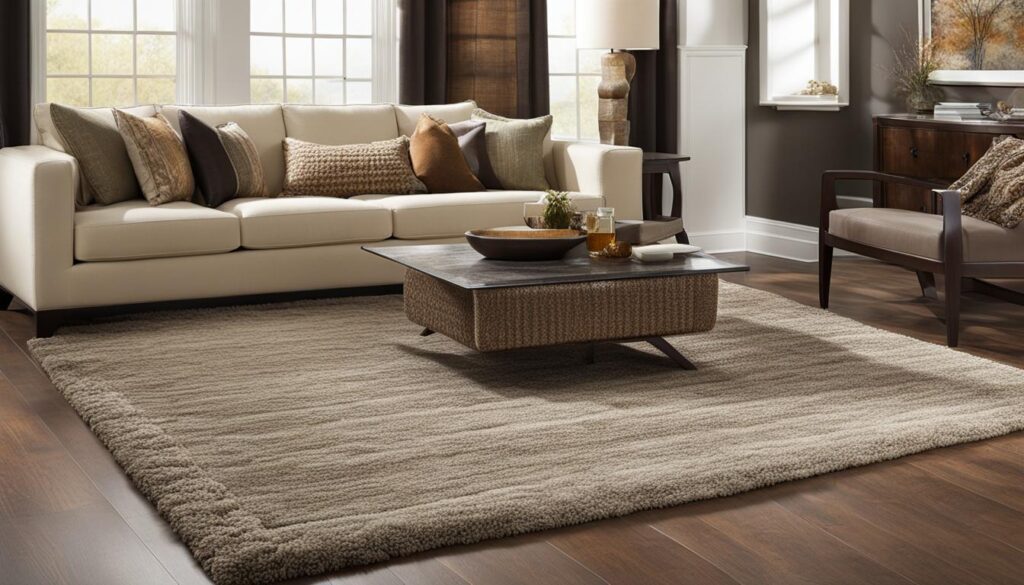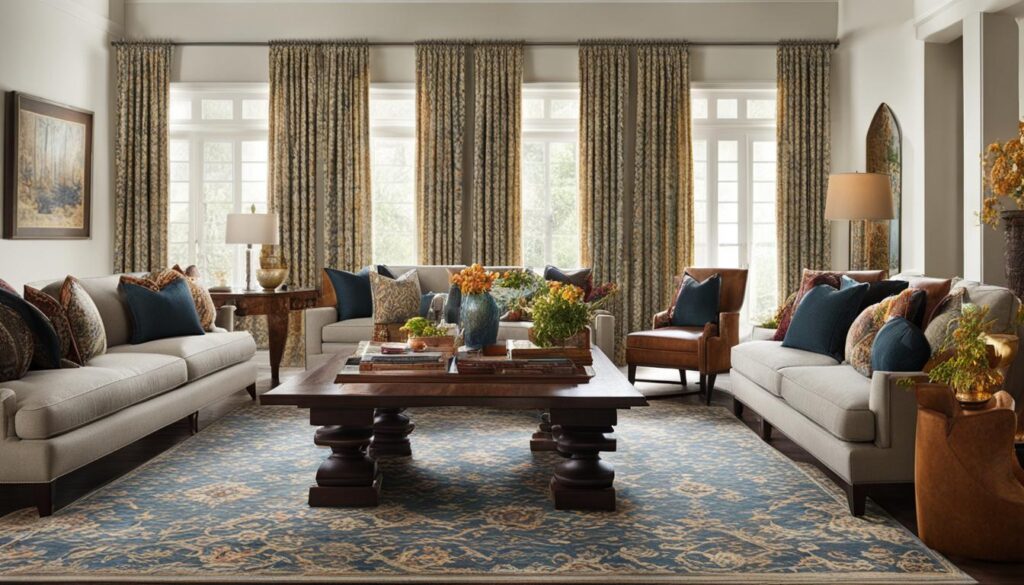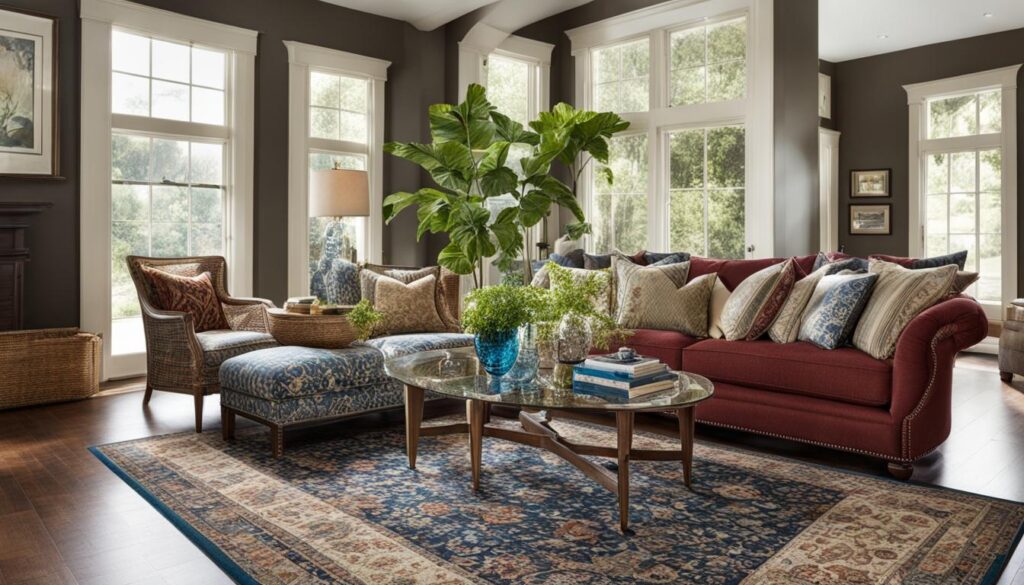As someone passionate about creating a warm and inviting home, I’ve learned that rugs are more than just a soft surface underfoot; they’re pivotal design elements that tie our spaces together. The rules for rugs, especially in the living room, are not just about aesthetics but also functionality and flow. Embracing the right carpet rules can transform how a room feels and is perceived. Whether you’re considering southern living rugs with their distinct charm or more contemporary choices, understanding the rules of area placement is key.
In my experience, a well-chosen rug enhances the sense of cohesion within a space. For example, rug rules living room spaces dictate can make or break the area’s overall vibe. When it comes to bedrooms and dining areas, the rules for area rugs offer comfort and functionality, ensuring every step is as purposeful as it is plush. Let’s dive deeper into these design guidelines and create harmonious spaces together.
Key Takeaways
- Area rugs should enhance room cohesion, with furniture placed correctly to create balance.
- Living room rug rules suggest that all or at least the front furniture legs should sit on the rug.
- The size of the rug in relation to the room is crucial; a larger rug can create an illusion of more space.
- For bedroom coziness, rugs should extend beyond the bed to offer comfort upon rising.
- Choosing rugs with durability and easy maintenance in mind is essential for high-traffic areas.
- Aligning rugs centrally in the room and ensuring consistent floor clearance creates a harmonious look.
The Impact of Rug Placement in Home Interiors
Understanding rules for rug placement and choosing the right rug size are foundational to crafting an inviting and well-defined living space. It’s a process I approach with both creativity and strategy, focused on determining how an area rug can influence the functionality and aesthetics of a room.


Defining Spaces with Area Rugs
When I consider how to choose an area rug, the power of an area rug to define and separate spaces within a home stands out. Its placement is critical in large, open-plan areas where it visually demarcates different living zones, bringing an innate warmth and coherence to the arrangement. By selecting designs that complement each other through colors or patterns, these rugs aid in subtly tying a room together.
Ensuring Proper Furniture and Rug Alignment
Choosing the right rug size involves careful deliberation, as it profoundly impacts both the balance and proportion of a room’s layout. The correct placement—like positioning just the front legs of the furniture on the rug—can seamlessly unify diverse elements, creating an organized, proportional look. In dining areas, it’s essential to ensure that the back legs of chairs remain on the rug even when moved away from the table to preserve cohesion and functionality.
The Visual Effect of Rug Dimensions on Room Size
- Rug dimensions notably alter the perception of space in a room.
- A large area rug makes an area feel more extensive and more luxurious, especially if it extends beneath most of the furniture and adequately covers walking paths.
- Maintaining a consistent gap between the borders of the rug and the room’s walls helps in sustaining balance and a sense of proportion.
Adhering to area rug guidelines not only elevates the look of a home’s interiors but also influences its spatial dynamics, offering an opportunity to make a powerful design statement.
Rules for Rugs: Selecting the Right Dimensions


When I decide to spruce up my living space, I focus on rug placement guidelines to ensure that the room feels both unified and comfortable. Choosing the right rug size isn’t just about finding a style that catches my eye; it’s about making practical decisions that impact room flow and maintenance. I’ve learned that considering rug size guidelines is just as important as the design when aiming for that perfect look and feel. It starts with visualizing the space and ends with a practical understanding of rug cleaning dos and don’ts.
Let’s talk about how I select the ideal rug for my space:
- Furnishing Companions: A rug should not only complement but also fit under essential furniture pieces—think sofas and tables—with ease, extending past them to maintain a cohesive appeal.
- High-Traffic Pathways: In areas where footfall is frequent, I ensure that my rug provides a delineated path to prevent wear and tear on the flooring underneath.
- Standard Sizing: I rely on commonly available rug sizes that match the standard room dimensions, which helps me steer clear of an awkward mismatch.
- Expert Measuring: My mantra is ‘measure twice, buy once’, so I take precise measurements to guarantee the rug I choose will be a perfect fit for the room and furniture it will grace.
- Open-Concept Adaptation: While the rule of thumb suggests maintaining an 18-inch margin of bare floor, I modify these guidelines in my sprawling open-concept areas to better fit the unique dimensions.
Remember, the right rug can tie a room together, but the wrong size can make a room feel disjointed or cluttered. By considering these factors, I ensure that my rug is not only aesthetically pleasing but also practical for daily use and upkeep.
Optimizing Area Rugs for Living Room Elegance
As I delve into the world of interior design, I’m often asked about the rug rules for living room elegance. To me, it’s about more than just the color or pattern—it’s about creating harmony between furniture and flooring. A well-placed rug can elevate the look of any living room, but it requires a keen eye for detail and an understanding of living room rug rules.
Balancing Furniture and Living Room Rug Rules
Achieving a sophisticated yet comfortable atmosphere in a living room often starts with rug placement rules. Allow me to share a little insider tip: arranging all furniture legs on the rug can unify diverse design elements, instantly creating a sense of luxury. On the flip side, placing only the front legs of your furniture on the rug can evoke a classic, traditional feel. It’s amazing how a simple shift in positioning can influence the entire aesthetic of a room.


Choosing the Correct Rug Size for a Cohesive Look
Finding the right rug size is paramount to designing a cohesive space. I recommend leaving about 18 inches of bare floor around the rug in typical-sized rooms. This not only anchors your furniture but also frames your living space beautifully. Conversely, in more petite living quarters, reducing the exposed floor area can make the room feel well proportioned and intimate, without the rug overwhelming the space.
Creating an Illusion of Space with Larger Area Rugs
- Utilizing larger area rugs can be a design game-changer, especially if you’re aiming to create the illusion of a more spacious living room.
- A large rug serves as a visual anchor, helping to define the seating area and providing a comfortable boundary for furniture placement.
- By ensuring that your furniture fits onto your rug, with ample space to walk around, you encourage the room to breathe, inviting an open and airy ambiance.
Irrespective of your aesthetic inclinations, the interplay of rug size, placement, and furniture balance are fundamental principals in achieving a living room that exudes elegance and sophistication.
Rug Etiquette for Bedrooms: Comfort Meets Style
In my constant journey to create the perfect bedroom oasis, I’ve found rug etiquette marries comfort with style effortlessly. A bedroom isn’t just a sleeping nook; it’s a sanctuary that demands both coziness and chic design. An essential part of this is rug positioning—ensuring that the first thing my feet touch in the morning is a plush, warm rug, which is as much about tactility as it is about the visual appeal. The rugs I choose not only complement the room’s aesthetics but also invite me to step into a new day with softness and warmth.
Positioning Rugs for a Warm Awakening
As for the nuances of positioning, I adhere to a few rug care tips to maintain that inviting feel. Having a rug extend a generous 18 inches beyond either side of my queen bed guarantees that every morning, my day starts with a touch of luxury. This consideration of space isn’t merely a functional choice; it sets the stage for my bedroom’s entire ambiance, ensuring consistency in the theme and an uninterrupted flow of style from bedding to floor.
Size Guidelines for Different Bed Sizes
When it comes to different bed sizes, the rug maintenance practices stay the same, while size guidelines slightly adjust. A wider berth is preferable for larger beds, but even with a twin or double bed, ensuring at least a 12-inch extension on either side makes a significant difference. And let’s not forget regular upkeep; following the rug cleaning instructions specific to each piece’s material helps retain its beauty and extends its life. By integrating these practices, the bedroom space isn’t just a place to sleep—it’s a realm where comfort meets elegance in every fiber.
FAQ
What are the basic rules for area rug placement in a living room?
In a living room, the rule of thumb is to have all furniture on the rug to create a unified space. However, if that’s not possible, at least the front legs of the major pieces should be on the rug. Ensure that the rug is large enough to define the seating area without being undersized.
How do I choose the right rug size for my living room?
To choose the right rug size, measure your seating area and select a rug that will fit all the furniture comfortably. Ideally, there should be about 18 inches of bare floor around the perimeter of the rug in standard-sized rooms. The rug should act as a foundation for setting up your furniture and defining the space.
What are some rug placement guidelines I should follow?
When placing a rug, aim for symmetry by leaving an equal amount of floor showing around the rug. Make sure the rug covers all the primary walking pathways in the room and extends beneath all the critical furniture pieces, like sofas or beds. In high-traffic areas, ensure that the rug is secured and remains flat to prevent tripping hazards.
Can the right rug create an illusion of more space in a room?
Absolutely! A larger rug can make a small room feel more expansive by extending up to, but not touching, the perimeter walls. Just ensure that the rug is proportional to the room’s size and furniture—to avoid making the space feel cluttered.
How do I align my furniture with my area rug?
For a cohesive look, align your furniture by placing the front legs on the rug, which ties the pieces together visually. In a dining room, ensure that the rug extends beyond dining chairs even when they’re pulled out. This maintains balance and protects your flooring.
What are the best practices for bedroom rug placement?
For bedroom rugs, position them so that stepping out of bed lands your feet on a plush, comforting surface. A good practice is to have the rug extend at least 18 inches beyond the sides of a king or queen bed, and at least 12 inches for twin or double beds. The rug should be proportional to the bed and space, creating a warm and inviting atmosphere.
How do I take care of my area rugs?
Rug care varies based on the material. For routine maintenance, vacuuming is essential. Always follow the specific cleaning instructions provided by the manufacturer. Some rugs may require professional cleaning, while others can be treated with DIY methods. Remember to address spills promptly to prevent staining.
Are there any dos and don’ts for cleaning area rugs?
Yes. Do vacuum regularly, treat stains immediately, and use rug protectors under heavy furniture. Don’t use harsh chemicals, refrain from over-wetting when cleaning, and avoid dragging furniture across the rug, which can damage both the rug and your floor.

